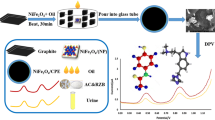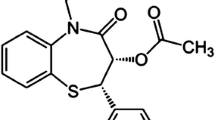Abstract
In this article, we report a methodology for the voltammetric behavior of meclizine hydrochloride at different nano modified electrodes e.g., Glassy carbon (GCE), pencil graphite (PGE), Carbon Nano tubes-carbon paste (CNTS-CPE) and Carbon Nano tubes-zinc oxide carbon paste (CNTS/ZnO-CPE) using cyclic and square wave voltammetry and the highest performance of them was CPE/CNTs/ZnO electrode and therefore was used as working electrode. The oxidation reaction mechanism of meclizine hydrochloride (MEC-HCL) is proposed to be one electron system. The results obtained with a square wave were linear over the concentration ranges 19.5–102.4 ng mL−1 with a correlation coefficient 0.998. The square wave technique showed a low of detectable (LOD) of 6.444 ng/mL and a limit of quantification (LOQ) of 19.530 ng/mL at CNTS/ZnO-CPE. Based on these findings, a simple and not time-consuming method was used for the analysis of MEC-HCL in pharmaceutics and biological fluids. The method showed a minimum detectability (LOD) of 0.02, 0.008 and 0.14 lg/mL and a limit of quantitation (LOQ) of 0.06, 0.02 and 0.42 lg/mL at PGE, CPE and GCE, respectively. The method was validated and compared with the reference valid method. It revealed good accuracy and reproducible results. The anticipated voltammetric procedure has the advantage of being simple, precise, inexpensive and highly sensitive.







Similar content being viewed by others
References
W. Martindale, S.C. Sweetman, Martindale: the complete drug reference (Pharmaceutical press, London, 1999)
V. Newman, J.T. Fullerton, P.O. Anderson, Clinical advances in the management of severe nausea and vomiting during pregnancy. J. Obstet. Gynecol. Neonatal Nurs. 22(6), 483–490 (1993)
E. Westgate, J. Sherma, Analysis of the active ingredient, meclizine, in motion sickness tablets by high performance thin layer chromatography with densitometric measurement of fluorescence quenching. J. Liq. Chromatogr. Relat. Technol. 24(18), 2873–2878 (2001)
N. Foda, H. Jun, J. McCall, Quantitative analysis of meclizine in tablet formulations by HPLC. Anal. Lett. 21(7), 1177–1188 (1988)
T. Al-Jallad et al., Simultaneous determination of pyridoxine hydrochloride and meclizine hydrochloride in tablet formulations by HPLC. Pharm. Pharmacol. Commun. 5(8), 479–483 (2000)
M.S. Arayne, N. Sultana, F.A. Siddiqui, Simultaneous determination of pyridoxine, meclizine and buclizine in dosage formulations and human serum by RP-LC. Chromatographia 67(11–12), 941–945 (2009)
R. Peraman et al., A stability-indicating RP-HPLC method for the quantitative analysis of meclizine hydrochloride in tablet dosage form. J. Chromatogr. Sci. 53(5), 793–799 (2015)
N. Sher et al., Simultaneous determination of antihistamine anti-allergic drugs, cetirizine, domperidone, chlorphenamine maleate, loratadine, meclizine and buclizine in pharmaceutical formulations, human serum and pharmacokinetics application. Anal. Methods 6(8), 2704–2714 (2014)
Z.J. Wang et al., Quantification of meclizine in human plasma by high performance liquid chromatography-mass spectrometry. J. Chromatogr. B Anal. Technol. Biomed. Life Sci. 879(1), 95–99 (2011)
M. Nawaz, A new validated stability indicating RP-HPLC method for simultaneous estimation of pyridoxine hydrochloride and meclizine hydrochloride in pharmaceutical solid dosage forms. Chromatogr. Res. Int. (1), 1–7 (2013)
M. Rambla-Alegre et al., Capillary electrophoresis determination of antihistamines in serum and pharmaceuticals. Anal. Chim. Acta 666(1–2), 102–109 (2010)
Y.H. Ho et al., Quantitative enantiomeric analysis of chlorcyclizine, hydroxyzine, and meclizine by capillary electrophoresis. Anal. Bioanal. Chem. 376(6), 859–863 (2003)
F. Hom, W. Ebert, Determination of meclizine hydrochloride by ion-pair extraction with methyl orange. J. Pharm. Sci. 66(5), 710–713 (1977)
M.M. Bkhaitan, A.Z. Mirza, Spectrophotometric method for determination of meclizine in pure and dosage form via ion pair complex formation using eosin Y. Curr. Pharm. Anal. 14(2), 95–100 (2018)
M. Rizk et al., Sensitive anodic voltammetric determination of methylergometrine maleate in bulk and pharmaceutical dosage forms using differential pulse voltammetry. J. Electroanal. Chem. 749, 53–61 (2015)
A. Shalaby et al., Electrochemical oxidation behavior of itraconazole at different electrodes and its anodic stripping determination in pharmaceuticals and biological fluids. J. Electroanal. Chem. 763, 51–62 (2016)
B. Uslu, S.A. Ozkan, Electroanalytical application of carbon based electrodes to the pharmaceuticals. Anal. Lett. 40(5), 817–853 (2007)
M. Rizk et al., Highly sensitive differential pulse and square wave voltammetric methods for determination of strontium ranelate in bulk and pharmaceutical dosage form. Electroanalysis 28(4), 770–777 (2016)
K. Kalcher, Chemically modified carbon paste electrodes in voltammetric analysis. Electroanalysis 2(6), 419–433 (1990)
K. Ravichandran, R. Baldwin, Chemically modified carbon paste electrodes. J. Electroanal. Chem. Interfacial Electrochem. 126(1–3), 293–300 (1981)
P.M. Ajayan, O.Z. Zhou, Applications of carbon nanotubes, Carbon nanotubes (Springer, Berlin, 2001), pp. 391–425
R.H. Baughman, A.A. Zakhidov, W.A. de Heer, Carbon nanotubes–the route toward applications. Science 297(5582), 787–792 (2002)
M. Endo, M.S. Strano, P.M. Ajayan, Potential applications of carbon nanotubes, in Carbon nanotubes (Springer, Berlin, 2007), pp. 13–62
R. Saito, G. Dresselhaus, M.S. Dresselhaus, Physical properties of carbon nanotubes, vol 35. (World Scientific, Singapore, 1998)
J. Wang, Carbon-nanotube based electrochemical biosensors: A review. Electroanalysis 17(1), 7–14 (2005)
W. Gao, J. Song, N. Wu, Voltammetric behavior and square-wave voltammetric determination of trepibutone at a pencil graphite electrode. J. Electroanal. Chem. 576(1), 1–7 (2005)
A. Levent, Y. Yardim, Z. Senturk, Voltammetric behavior of nicotine at pencil graphite electrode and its enhancement determination in the presence of anionic surfactant. Electrochim. Acta 55(1), 190–195 (2009)
M. Ozsoz et al., Electrochemical genosensor based on colloidal gold nanoparticles for the detection of Factor V Leiden mutation using disposable pencil graphite electrodes. Anal. Chem. 75(9), 2181–2187 (2003)
C. Chen et al., Zinc oxide nanoparticle decorated multi-walled carbon nanotubes and their optical properties. Acta Mater. 54(20), 5401–5407 (2006)
W. Zhang et al., Synergistic effects of nano-ZnO/multi-walled carbon nanotubes/chitosan nanocomposite membrane for the sensitive detection of sequence-specific of PAT gene and PCR amplification of NOS gene. J. Membr. Sci. 325(1), 245–251 (2008)
H. Zittel, F. Miller, A glassy-carbon electrode for voltammetry. Anal. Chem. 37(2), 200–203 (1965)
R.L. McCreery, Carbon electrodes: structural effects on electron transfer kinetics. Electroanal. Chem. 17, 221–374 (1991)
W. Van der Linden, J.W. Dieker, Glassy carbon as electrode material in electro-analytical chemistry. Anal. Chim. Acta 119(1), 1–24 (1980)
M. Gattrell, D. Kirk, The electrochemical oxidation of aqueous phenol at a glassy carbon electrode. Can. J. Chem. Eng. 68(6), 997–1003 (1990)
S.A. Kumar, S.M. Chen, Nanostructured zinc oxide particles in chemically modified electrodes for biosensor applications. Anal. Lett. 41(2), 141–158 (2008)
M.J. Dewar, W. Thiel, Ground states of molecules. 38. The MNDO method. Approximations and parameters. J. Am. Chem. Soc. 99(15), 4899–4907 (1977)
M.J. Dewar, W. Thiel, Ground states of molecules. 39. MNDO results for molecules containing hydrogen, carbon, nitrogen, and oxygen. J. Am. Chem. Soc. 99(15), 4907–4917 (1977)
M.J. Dewar, W. Thiel, A semiempirical model for the two-center repulsion integrals in the NDDO approximation. Theor. Chim. Acta 46(2), 89–104 (1977)
H.T.S. Britton, R.A. Robinson, CXCVIII.-Universal buffer solutions and the dissociation constant of veronal. J. Chem. Soc. (1), 1456–1462 (1931)
E. Laviron, General expression of the linear potential sweep voltammogram in the case of diffusionless electrochemical systems. J. Electroanal. Chem. Interfacial Electrochem. 101(1), 19–28 (1979)
B. Rezaei, S. Damiri, Voltammetric behavior of multi-walled carbon nanotubes modified electrode-hexacyanoferrate(II) electrocatalyst system as a sensor for determination of captopril. Sens. Actuators B 134(1), 324–331 (2008)
D. Pletcher et al., 6 - Potential sweep techniques and cyclic voltammetry, Instrumental Methods in Electrochemistry, ed. by D.P.G.P.M.P. Robinson (Woodhead Publishing, Cambridge, 2010), pp. 178–228
D.K. Gosser, Cyclic voltammetry: simulation and analysis of reaction mechanisms (VCH, New York, 1993)
A.J. Bard, L.R. Faulkner, Electrochemical Methods Fundamentals and Applications, second edn. (John Wiley and Sons, New York, 2001)
J.N. Miller, J.C. Miller, Statistics and chemometrics for analytical chemistry (Pearson/Prentice-Hall, Harlow, 2005)
Acknowledgements
This work was supported by NODCAR Egypt.
Author information
Authors and Affiliations
Corresponding author
Electronic supplementary material
Below is the link to the electronic supplementary material.
Rights and permissions
About this article
Cite this article
Hendawy, H.A.M., Abdellatef, H.E., Hassan, W.S. et al. Voltammetric determination of meclizine HCL and its application in pharmaceuticals and biological fluid using CNTS/ZnO nano-carbon modified electrode. J IRAN CHEM SOC 15, 1881–1888 (2018). https://doi.org/10.1007/s13738-018-1385-0
Received:
Accepted:
Published:
Issue Date:
DOI: https://doi.org/10.1007/s13738-018-1385-0




